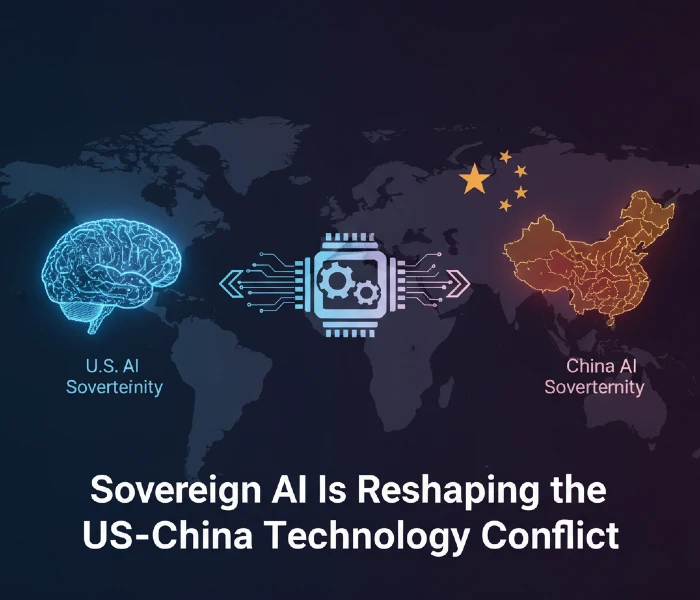In the 21st-century power struggle, artificial intelligence has become the defining technology of global influence—and sovereign AI is at the heart of this contest. As the United States and China compete for leadership in AI, their focus has shifted from innovation to control. No longer is it enough to develop cutting-edge models or deploy massive data centers. The new battleground lies in sovereign AI, where nations seek to govern every layer of the AI stack—from hardware and compute to training data, algorithms, and deployment infrastructure—without depending on foreign entities.
This has turned the sovereign AI in US‑China tech war into a high-stakes confrontation that touches on economic independence, military strategy, digital lawmaking, and international diplomacy. The U.S. has tightened export restrictions on advanced semiconductors and AI chips, while China accelerates domestic innovation and builds parallel AI ecosystems to reduce reliance on Western technology. In response, both nations are investing heavily in AI research, expanding data center capacity, and influencing global standards to gain an upper hand in shaping the future of AI governance.
As this AI race intensifies, its impact is being felt far beyond Silicon Valley or Shenzhen. Sovereign AI is redrawing alliances, forcing smaller nations to choose sides, and reshaping the global digital landscape into competing spheres of influence. This article explores how sovereign AI in the US‑China tech war is redefining the balance of power in the emerging AI era—and what it means for the world moving forward.
Defining Sovereign AI and Its Strategic Implications
Many confuse sovereign AI with simply hosting servers domestically, but the real challenge lies in owning the entire stack. The core of sovereign AI in US‑China tech war is ensuring that every layer—from chips to model weights to deployment—is under national or allied control, reducing external dependency.
When China or the U.S. seeks sovereign AI dominance, it is making a statement: that technological autonomy matters as much as territorial borders. Controlling AI infrastructure yields influence over allied states, ensures compliance with domestic laws, and shields against external coercion in times of crisis.
Yet sovereignty demands more than national ambition. It requires investment in hardware, skilled talent, regulatory systems, and resilient supply chains. Nations that adopt sovereign AI without these foundations risk creating hollow sovereignty—power in name, but dependency in practice.
Infrastructure, Chips, and the Hardware Constraint
The phrase sovereign AI in US‑China tech war becomes stark when we look at who controls semiconductors and data infrastructure. The U.S. has leveraged export controls to restrict advanced chips to China, limiting China’s access to cutting‑edge hardware.
China, responding to those constraints, is aggressively expanding its domestic chip capability and reducing dependency on exports. These moves show how sovereign AI is no longer just a software argument but a hardware war.
Still, infrastructure sovereignty is fragile. A nation may build data centers, but if the operator is a foreign company, sovereignty is compromised. A recent study of 775 non‑U.S. data centers concluded that building local infrastructure does not guarantee true sovereignty if legal control lies outside.
Open Source vs Proprietary Models as a Sovereignty Vector
In the sovereign AI in US‑China tech war discourse, one of the fiercest debates is whether models should be open or proprietary. The U.S. often favors closed models to protect IP and control usage, while China has embraced open weights as a method of influence and diffusion.
China’s open strategy allows developers globally to adopt its models—spreading influence and creating dependencies. The U.S., meanwhile, partners sovereign AI projects with stricter control, tying models to alliances and trusted networks.
But open does not automatically equal sovereignty. Open models must be supported by local governance, security audits, and regulatory oversight. Without that, open models become soft power tools in another flag’s hands.
Alliances, Tech Diplomacy, and Rival Spheres
Sovereign AI in US‑China tech war shapes alliance strategies. Countries are now asked to pick their AI stack allegiance—one that may influence trade, diplomacy, and security alignment.
The U.S. has pushed partnerships with allied governments to deploy AI systems that align with Western values and standards. China counters by offering open models and infrastructure collaboration to nations willing to adopt its ecosystem.
This digital alignment often precedes military or trade alignment. Nations that commit to one AI stack may face limitations in integrating with the other, narrowing future options in diplomacy, economics, and security.
Risks, Fragmentation, and a Divided Digital World
One serious consequence of sovereign AI in US‑China tech war is fragmentation. The world might split into regional AI zones that are incompatible, with limited interoperability across spheres.
This fragmentation undermines global collaboration on shared challenges—climate modeling, health research, science. The loss of data flow and cross-border innovation will slow collective progress.
Moreover, tensions may cause retaliation: export bans, AI embargoes, or forced model audits. Nations without strong sovereign AI foundations may become de facto clients or subjects in digital power plays.
FAQs
What is sovereign AI exactly?
Sovereign AI means controlling the full AI stack—hardware, data, models, deployment—within national or trusted alliance jurisdiction.
Why is sovereign AI central to US‑China tech competition?
Because AI control translates into influence, leverage, and strategic autonomy in technology, security, and digital governance.
Can smaller countries build sovereign AI?
It’s possible but hard. It demands investment in chips, infrastructure, human capital, regulation, or else reliance on alliances.
Which model approach is more sustainable: open or proprietary?
Neither is perfect—open allows diffusion and influence, proprietary gives control. The sustainable path often mixes both with governance and oversight.
Will sovereign AI lead to a fragmented digital world?
Yes, unless bridges or interoperability frameworks emerge. Fragmentation risks hindering global cooperation and innovation.
Check our latest news
Top 5 Opportunities for Startups After Google’s Massive AI Funding in U.S. & India.
Global Financial System Resilient Despite AI Speculation, IMF Economist Claims



